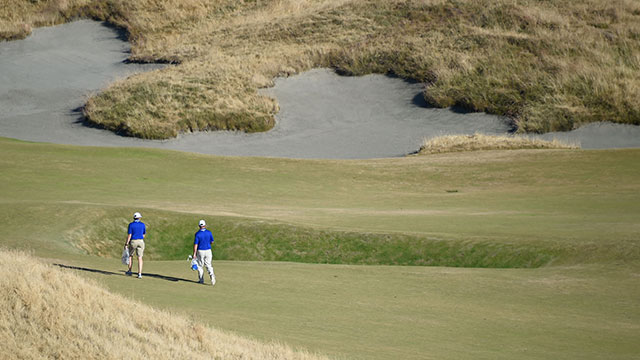NEWS
Chambers Bay's flexibility shows on holes 1, 18

UNIVERSITY PLACE, Wash. -- It will be shortly before their tee times Thursday morning when the 156-player field in the 2015 U.S. Open learn whether Nos. 1 and 18 at Chambers Bay will be playing as a par-4 or par-5.
And that's just the way USGA Executive Director Mike Davis wants it.
"We have made that decision," Davis said, "I know there's probably some saying, 'Why did you change up Nos. 1 and 18?' The way the architects designed the holes, they did it with flexibility in mind."
If No. 1 plays as a par-4, No. 18 will play as a par-5, and vice-versa. "Those two holes are really a par-9," Davis said.
No. 1 will play to 496 yards as a par-4 and 598 yards as a par-5, while No. 18 will play to 525 and 604 yards, respectively. And, Davis said, the two holes will play completely differently depending on the par.
"They're two completely different drive zones," he said. "The greens can be very severe and almost add the element of risk and reward with hole locations. The bunkering is different. We went into (it) thinking this is going to be the right thing to do."
Davis said he figures players have been practicing with both contingencies in mind and will be prepared for either one. He gave no indication whether the holes will be changed daily, if at all.
Flexibility was the watchword throughout Davis' lengthy discussion of how he has approached the setup at Chambers Bay, an eight-year-old public course that is hosting a major for the first time.
"I've been hearing a lot about this golf course being so flexible," he said. "It is. But at the same time, there's a lot of flexibility on what the players can do. Oftentimes, particularly at traditional courses, you essentially have one way to play a shot. (Here) there are a lot of options into greens, and even on the greens with some of the pronounced undulations.
"And there are options off the teeing ground. It won't surprise me that some holes you'll see a group of three and somebody hits a driver, somebody hits a 3-wood and somebody hits an iron. They're thinking through course management and we would give that a big thumbs-up."
LEADERBOARD: Round 1 at the U.S. Open | CHAMBERS BAY: It's showtime
Other highlights of the 45-minute press conference:
-- Davis said the course will play between 7,300 and 7,700 yards, but with the dry conditions and roll, he doesn't feel the big hitters have a significant advantage.
-- Davis said he expects the greens to play at 111/2-12 on the Stimpmeter, and the fine fescue grass to produce faster greens as the day progresses.
-- More than half the field -- 80 players -- made it through qualifying rounds that began with nearly 10,000 entries. Sixteen amateurs are in the field and 26 countries are represented.
-- Davis estimates rounds should take 4 hours, 45 minutes for the early groups in the field. Slowing the pace will be green-to-tee walking times of 21 minutes, compared to 13 last year at Pinehurst and 11 two years ago at Merion.
Fowler bucking trend: Jupiter's Rickie Fowler took issue with Davis' comments from several weeks ago that players who didn't show up until the week of the tournament have no hope of winning. He arrived over the weekend.
"Well, I like to think I have some hope," he said. "I enjoy the golf course. I don't see it as far as needing to have a bunch of different rounds around here and playing a bunch of different tees. The biggest thing is understanding the ground and the greens and angles and where you can play shots and where you can't hit it to and where you can hit it to."
Fowler's results on links courses -- two top-fives in five British Open appearances, including a second last year -- back him up as he looks to win his first major.
This article was written by Brian Biggane from The Palm Beach Post and was legally licensed through the NewsCred publisher network.
